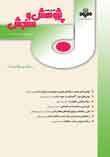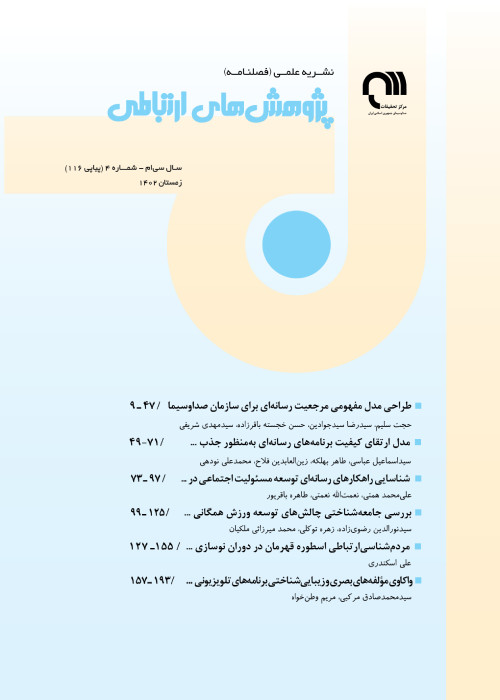فهرست مطالب

فصلنامه پژوهش های ارتباطی
پیاپی 49 (بهار 1386)
- تاریخ انتشار: 1386/01/20
- تعداد عناوین: 8
-
صفحه 7
-
صفحه 9رسانه های جمعی یعنی منابع اصلی اطلاعات، در همه جا حضور دارند و اثرات مهمی بر سلامت عمومی به جا می گذارند. اثرات رسانه بر رفتارهای مربوط به سلامت نه تنها از دیدگاه تعاملات روزانه، بلکه به منظور کاربرد برنامه ریزی شده رسانه ها در تغییر رفتار مطالعه می شود. این مقاله، پس از ذکر دلایل استفاده از رسانه های جمعی در حوزه سلامت، به بحث درباره دو حوزه پژوهشی مرتبط با رسانه ها و سلامت (تولید پیام و تاثیر پیام) می پردازد و سپس عوامل موثر بر تولید برنامه های موفق مربوط به سلامت و عواملی را که مانع از تولید چنین برنامه هایی می شوند فهرست وار معرفی می کند.
در پایان نیز چند موضوع مهم که پژوهش های مربوط به رسانه وسلامت را به چالش می کشند، ارائه شده است.
کلیدواژگان: تولید پیام، تاثیر پیام، رسانه جمعی، سلامت، شکاف آگاهی، بسیج رسانه ای -
صفحه 29مقاله حاضر با بررسی روش های موثر آگاه سازی و آموزش در حوزه سلامت، به دو شیوه آموزش سنتی و نوین در این زمینه می پردازد. نگارنده معتقد است در حالی که مدل های سنتی آموزش سلامت، بر جنبه های فردی و معمول تاکید دارند، در آموزش های نوین، تاکید بر توانمند سازی و عمل اجتماعی است. اگر آموزش تعاملی و مقتدرساز در حوزه سلامت از طریق رسانه اجرا شود، ارزش ها، نگرش ها و رفتارها به مرور در فرد و جامعه تغییر خواهند یافت زیرا در روش های نوین آگاه سازی، به برانگیختن سطحی فرد و جامعه بسنده نمی شود بلکه سعی در تعمیق آگاهی پیام گیران و انگیزش حس مشارکت واقعی آنهاست.
کلیدواژگان: آگاه سازی موثر، رسانه، سلامت -
صفحه 43حضور بیش از 600 میلیون فرد دارای ناتوانی در جهان، موضوع معلولیت و ناتوانی را به مسئله ای مهم در جوامع انسانی تبدیل کرده است. نگرش منفی نسبت به ناتوانی و معلولیت پدیده ای تاریخی است که در طول زمان تا حدی تحول و بهبود یافته است. سازمان ملل متحد، سازمان های وابسته به آن و سازمان های غیردولتی معلولان از سال 1980، تلاشی فزاینده را برای تغییر نگرش منفی نسبت به معلولیت آغاز کرده و ادامه داده اند. رسانه نیز به عنوان پدیده ای غیرقابل انکار در زندگی بشر امروز، طی همین سال ها، بارزترین جلوه برخورد مردم با پدیده ناتوانی و معلولیت بوده است. مطالعات نشان می دهد کلیشه های منفی، اصلی ترین عنصر در نمایش ناتوانی و معلولیت در رسانه ها بوده اند. تصویر افراد دارای ناتوانی و معلولیت در رسانه ها، اغلب با کلیشه هایی همچون افراد قابل ترحم، قربانی خشونت، شریر و شیطانی، مرموز و بیگانه، قدرت ماورایی، سرگرم کننده و خنده آور، دشمن خویش، باری بر جامعه و فاقد قدرت مشارکت اجتماعی همراه بوده است. رسانه های پیشرو تلاش کرده اند با تغییر این نگاه، زمینه توجه به معلولان را به عنوان شهروندان عادی جامعه، فراهم نمایند. در بسیاری از جوامع دستورالعمل های چگونگی نمایش معلولان در رسانه ها آغاز شده است. شناخت دقیق کلیشه های منفی و تلاش برای غلبه بر آنها منجر به حضور بیشتر و فعال تر معلولان در جامعه خواهد شد.
کلیدواژگان: ناتوانی، رسانه، کلیشه های منفی -
صفحه 67سلامت شهرنشینی، بیش از هر چیز سلامت اجتماعی را در نظر دارد زیرا شهر نشینی پدیده ای اجتماعی است. از سویی، فلسفه وجودی رسانه های گروهی نیز در قالب زیست جمعی و زندگی اجتماعی قابل تعریف است. بنابراین می توان گفت سلامت اجتماعی، رسانه و زندگی شهری، از اساس دارای پیوندی درونی هستند و به این ترتیب در مهندسی سلامت اجتماعی و زندگی شهری، توجه به رسانه ها بسیار حایز اهمیت است. مقاله حاضر نشان می دهد که چگونه بی توجهی مدرنیسم به زندگی شهری در غرب، موجب بروز مشکلات بسیاری در زمینه سلامت اجتماعی شده است. بدیهی است که رسانه ها نیز می توانند در این میان شمشیری دو لبه باشند؛ یعنی هم در جهت تخریب سلامت اجتماعی حرکت کنند و هم در جهت بازتولید آن زیرا مهم ترین نهاد الگوساز در هر جامعه، رسانه های عمومی هستند.
کلیدواژگان: شهرنشینی، رسانه، تلویزیون، سلامت اجتماعی، تصویر، وانمودگی واقعیت، شیوه زیست -
صفحه 87گستردگی رسانه های جمعی، ایجاد و انتقال جریان نامحدودی از اطلاعات را در جامعه امروز موجب شده است. این اشباع رسانه ای، نگرانی های خاصی را در خصوص مسائل مربوط به سلامت پدید آورده است. رویارویی با رفتارهای پرخطر در رسانه های جمعی مانند تلویزیون، سینما، بازی های رایانه ای، اینترنت و... خطری جدی برای سلامت کودکان و نوجوانان به شمار می رود و تاثیر رسانه ها بر سلامت نوجوانان در زمینه تغذیه، اطلاعات جنسی، الکل، دخانیات، خشونت و فشارهای روانی همچنان مورد بحث است. رسانه ها بیشترین فرصت و زمان را برای شکل دهی به عقاید و رفتارهای جوانان در اختیار دارند و جایگزین والدین و مربیان به عنوان مربی و منبع اولیه اطلاعات درباره دنیا و چگونگی رفتار افراد در آن شده اند. با توجه به بالا بودن قدرت انتشار رسانه ها و خطرات احتمالی انتقال اطلاعات غیردقیق یا حذف اطلاعات حیاتی، همکاری بیشتر و مؤثرتر جوامع بهداشتی و رسانه های جمعی امری ضروری است.
کلیدواژگان: رسانه، رفتارهای پرخطر، سیگار، خشونت، رفتارهای جنسی -
صفحه 103مقاله حاضر جستاری است درباره چگونگی طرح و اولویت یافتن اخبار مربوط به بیماری ایدز در رسانه های امریکا.
نویسنده، ابتدا به زمینه های بروز این بیماری در سانفرانسیسکو و طرح توام با تاخیر اخبار آن در رسانه های این ایالت اشاره می کند و سپس مراحل عبور این اخبار را از دو قطب اساسی تعیین اولویت خبر در امریکا؛ یعنی روزنامه ملی نیویورک تایمز و کاخ سفید شرح می دهد.
اخبار مربوط به ایدز در سال 1981 برای اولین بار، در رسانه های سانفرانسیسکو طرح شد اما تا سال 1985 که رسانه های سراسر امریکا، به تبعیت از روزنامه نیویورک تایمز به برجسته سازی اخبار این بیماری مبادرت کردند، توفیق طرح و برجسته سازی در رسانه های ملی امریکا را نیافت!
کلیدواژگان: رسانه های امریکا، ایدز، برجسته سازی، کاخ سفید، نیویورک تایمز -
صفحه 113مقاله حاضر کنکاشی است پیرامون نقش رسانه در ارتقا یا تضعیف سلامت جسمی و روانی خانواده.
نویسنده برای تبیین موضوع، با برجسته کردن کارکرد آموزشی رسانه، روش های مستقیم و غیرمستقیم القای مفاهیم مربوط به حوزه بهداشت و سلامت را از طریق رسانه های دیداری و شنیداری برمی شمرد.
همچنین در بخشی از مقاله به تحولات خانواده در دوران معاصر اشاره شده که رسانه ها جهت تاثیرگذاری بیشتر و انطباق برنامه ها با واقعیات اجتماعی باید به آنها توجه کنند.
کلیدواژگان: سواد سلامتی، رویکرد سلامت محور، نظریه بازتاب رسانه ای، سلامت اخلاقی، نظریه کنترل اجتماعی، جدایی عاطفی، خانواده زیستی، خشونت خانگی
-
Page 9Mass media i.e. major sources of information are omnipresent and have a significant impact on public health. The effects of media on health-related behaviors are not only studied for the analysis of dayto- day interactions but also for the planned application of media to change public behaviors.The present article, first; specifies the reasons for which media are used in health domain. It, secondly; discusses two major research areas related to media and health (message production and message effect).Thirdly; it introduces briefly the factors influencing theproduction of successful programs addressing health and also factors impeding production of such programs. It finally proposes a few important subjects which challenge researchon media and health.
-
Page 29Reviewing the effective methods of health training, the present article addresses two methods of training; traditional and modern. The author believes that while the traditional methods of health training emphasize on individual and usual aspects, the modern methods focus on empowerment and social action. If interactive and empoweringeducation in the field of health is done through media, then, values, attitudes, behaviors would gradually change in individuals and society because the modern methods of education do not suffice to superficial stimulation of individuals and the society, but they attempt to deepen the awareness of the message recipients and arouse their real sense of cooperation.
-
Page 43There are more than 6oo million disabled people across the world and this has made disability an important issue in human communities. Negative attitude towards disability is a historical phenomenon which has improved along the time. The UN and its affiliates along with the disabled NGOs have launched a campaign since 1980 to fight thisnegative outlook. Nowadays, media, as an undeniable phenomenon in people’s daily life, have been the most obvious presentation of people’ behavior towards the issue of disability. Study shows that the negative prototypes have been the main element in presentation of disability in media. The image of the disabled in media is usually associated with negative connotations such as misery, wickedness, mystery, supernaturalness,amusement, laugh, self-destruction, being parasite to society, being victims of violence, etc. The pioneering media have attempted to change this outlook toward the disabled and depict them as common citizens. In many communities, prescriptions for presenting the disable have been provided. Gathering a better knowledge about negative prototypes and attempts to hehpaherara overcome disability leads to more activepresence of the disabled in the society.
-
Page 67On the one hand, citizenship health mostly has to do with social health, for citizenship is a social phenomenon. On the other, the philosophy of mass media can only be defined with the presupposition of a collective lifestyle. Hence, social health, media and citizenshipare presumably interwoven and the position of media in engineering social health and citizenship is a lofty one. The present article shows that how modernism’s ignorance ofcitizenship in the West has brought about many problems in the field of social health. It is obvious that the role of media is twofold here; in other words, media can contradictorily have both a destructive role and a constructive one towards social health for media are the most effective model-setting institutions in a society.
-
Page 87The increasing amount of mass media has brought about an infinite wave of information being created and transferred in societies.This media saturation has caused some concerns regarding health issues. Exposure to risky behaviors in media such as TV, cinema,computer games, internet, etc is a serious risk for the children and adolescent’s health. The effect of media on the adolescent’ health regarding issues like nutrition, sex information, alcohol, drugs, violence and stress, is also a matter of continuous debate. Media have the most and best opportunity and capacity to shape adolescent’sbeliefs and behaviors and play the role of parents and trainers as the first source of information about the world. Given the extreme power of mass media to circulate widely and the possible risk of transferring misleading information or deleting necessary information, it is vital for the health communities and mass media to cooperate moreeffectively.
-
Page 103The present article is an attempt to explore how news related to the issue of AIDS is presented and highlighted in the US media. The author first mentions the causes of the disease in San Francisco and media’ plan to release its news with delay and then describes the process of its passing to two major poles of authorities which usually determine news ranking in the US i.e. New York Times and the White House.The news of AIDS was for the first time released in San Francisco’s media in 1985, however it was not until 1985 that the US media, following New York Times, could have the chance of highlighting the new of this disease.
-
Page 113The article attempts to explore the role of media in improving or deteriorating the physical and mental health of family. Underlining the educational function of media, the author specifies direct and indirect methods of instilling concepts related to the field ofhealth and hygiene via audio-visual media. The article partly addresses developments related to family in the contemporary era which the media should take into account for having more impact on the audience as well as for basing their productions on the social facts.


